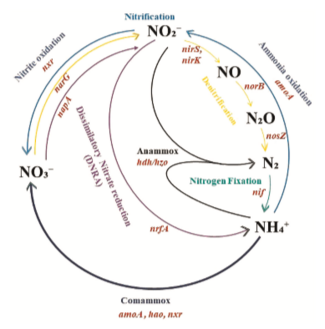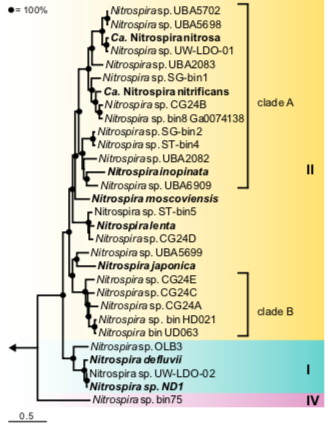Nitrospira inopinata
Classification
Higher Order Taxa
Domain Bacteria
Phylum Nitrospirota
Class Nitrospira
Order Nitrospirales
Family Nitrospiraceae
Genus Nitrospira
Species
Candidatus Nitrospira inopinata
Description and Significance
Candidatus Nitrospira inopinata was first obtained in 2011 from a microbial biofilm formed on the metal surface of a pipe which was raised from 1,200 meters deep oil exploration well in Russia. The temperature of this environment was 56 degrees Celsius and the pH was 7.5 (Daims et al., 2015). A pure culture of Ca. N. inopinata was later obtained in 2017. Currently, Ca. N. inopinata is the only comammox bacteria to be successfully isolated and cultured. The available culture is from an aquatic environments, and there is a lack of cultures from terrestrial environments (Li et al., 2022).
Ca. N. inopinata is a bacterium within the phylum Nitrospirota. Nitrospirota is a phylum containing nitrite-oxidizing bacteria that play an important role in nitrification. Nitrification is the oxidation of ammonia via nitrite to nitrate. Ammonia-oxidizing bacteria (AOB) convert ammonium (NH4+) to nitrite (NO2-) and nitrite-oxidizing bacteria (NOB) convert nitrite (NO2-) to nitrate (NO3-). Ca. N. inopinata is the first complete ammonium-oxidating (comammox) bacterium to be discovered, and it has the ability to perform the nitrification process in one step. This involves the complete ammonia (NH4+) oxidation to nitrate (NO3-).
Nitrification and other transformations of nitrogen species is important in both natural and engineered systems. In biological wastewater treatment, nitrification by microbial organisms plays an important role in the removal of excess nitrogen compounds.
Genome Structure
The complete genome sequencing of Ca. N. inopinata, using enrichment culture ENR4, was first completed in December of 2015, and later published in "Nature." The genome size is 3.3 Mbp, and includes 3,105 genes with a 59.2% GC content (NCBI).
The genus Nitrospira is classified into six sublineages. Due to the presence of nxrA and nxrB genes, comammox Ca. N. inopinata fits into sublineage two, which is further comprised of clades A and B (Vijayan et al., 2020). However, since comammox bacteria do not form a monophyletic group within sublineage two, 16S rRNA-based methods cannot be used to distinguish comammox bacteria from nitrite-oxidizing bacteria (Koch et al., 2019). Thus, other molecular techniques such as metagenomics and functional gene-based PCR assays are used to detect complete nitrifiers. Comammox bacteria can also be found using direct-gene FISH, and the detection of ammonia oxidation enzymes such as the amoA gene or AMO protein, which tend to be higher in abundance (Koch et al., 2019). Ca. N. inopinata possesses the key enzyme for nitrite oxidation, nitrite oxidoreductase (NXR) and this can be distinguished within the genome by the presence of nxrA and nxrB genes. Along with NXR and AMO enzymes, Ca. N. inopinataalso possesses hydroxylamine oxidoreductase, or HAO enzymes (Daimes et al., 2015).
Ecology
The population structure and ecological diversity of Nitrospira is closely related to the nitrite oxidation pathway. The utilization of organic compounds such as nitrite and carbon dioxide creates metabolic versatility among species. Other environmental factors such as temperature, pH, and dissolved oxygen can also affect the diversity of species found in ecosystems. For commamox Nitrospira, systems with low or limited substrate input was found to have a higher comammox response (Vijayan et al., 2020). Due to the high ammonia affinity of Ca. N. inopinata, it is suggested that this species prefers oligotrophic, or low nutrient, environments (Li et al., 2022).
Ca. N. inopinata and other comammox Nitrospira play a key role in the oxidation of nitrogen compounds in natural and engineered ecosystems. In engineered systems such as wastewater treatment plants, comammox Nitrospira are often more abundant than ammonia oxidizers. This may be due to their ability to thrive in low ammonium environments.
Cell Structure & Metabolism
Ca. N. inopinata is spiral shaped with the presence of a flagellum. Size of the species ranges from 0.18-0.3 x 0.7-1.6 μm (Vijayan et al., 2020).
Comammox bacteria are characterized by slow growth rates but higher growth yields. Biofilm formation is commonly associated within Nitrospira lineages, and these formations tend to increase with stress. Species such as Ca. N. inopinata commonly develop microcolonies, or aggregates, in which their growth is visible in the form of densely packed cells. These colonies vary in size but tend to have a diameter between 5-20 μm. During starvation or with the presence of other environmental stressors, the cells could return to a planktonic state. This interchanging behavior serves as an adaptation, which is a beneficial survival mechanism.
New research shows that Ca. N. inopinata and other comammox species could exhibit chemolithoautotrophic growth during complete nitrification (Vijayan et al., 2020). Ca. N. inopinata also displays a mixotrophic lifestyle in which they have the ability to utilize both autotrophic and heterotrophic pathways. This allows them to use both organic and inorganic energy sources.
Current Research
Current research is looking into the practical applications of Ca. N. inopinata which ranges from wastewater treatment, drinking water and soil purification, and climate change research (Willis, 2020). As a comammox bacteria, Ca. N. inopinata has the potential to reduce the amount of ammonium contributing to environmental issues, and help rebalance Earth's nitrogen cycle. Further research is needed to better understand the global importance of comammox bacterium, and more targeted approaches to identify and isolate comammox Nitrospira are needed to identify niche-separating physiological features as well as to assess the ecological significance of complete nitrification in both natural and engineered systems (Koch et al., 2019).
Micropollutants such as pesticides and pharmaceuticals occur at low levels and are considered environmental concerns due to their potential for adverse effects of human health. Biotransformation of micropollutants is essential to their removal, especially in water water treatment plants (WWTPs). Due to the abundance of comammox bacteria in WWTPs they may contribute to micropollutant biotransformation. Current research is looking to better understand their role (Han et al., 2019). Preliminary research has found that Ca. N. inopinata can biotransform compounds such as carbendazim and mianserin, that other ammonia oxiders cannot.
Literature Cited
Daims, H., Lebedeva, E.V., Pjevac, P., Han, P., Herbold, C., Albertsen, M., Jehmlich, N., Palatinszky, M., Vierheilig, J., Bulaev, A. and Kirkegaard, R.H. (2015). Complete nitrification by Nitrospira bacteria. Nature, 528(7583), 504-509.
Han, P., Yu, Y., Zhou, L., Tian, Z., Li, Z., Hou, L., Liu, M., Wu, Q., Wagner, M. and Men, Y. (2019). Specific micropollutant biotransformation pattern by the comammox bacterium Nitrospira inopinata. Environmental Science & Technology, 53(15), 8695-8705.
Koch, H., van Kessel, M. A., & Lücker, S. (2019). Complete nitrification: insights into the ecophysiology of comammox Nitrospira. Applied Microbiology and Biotechnology, 103, 177-189.
Li, C., He, Z. Y., Hu, H. W., & He, J. Z. (2022). Niche specialization of comammox Nitrospira in terrestrial ecosystems: Oligotrophic or copiotrophic?. Critical Reviews in Environmental Science and Technology, 53(2), 161-176.
U.S. National Library of Medicine. (n.d.). Candidatus Nitrospira inopinata - NCBI - NLM. National Center for Biotechnology Information. Retrieved March 20, 2023, from https://www.ncbi.nlm.nih.gov/data-hub/taxonomy/1715989/
Vijayan, A., Vattiringal Jayadradhan, R. K., Pillai, D., Prasannan Geetha, P., Joseph, V., & Isaac Sarojini, B. S. (2021). Nitrospira as versatile nitrifiers: Taxonomy, ecophysiology, genome characteristics, growth, and metabolic diversity. Journal of Basic Microbiology, 61(2), 88-109.
Wikimedia Foundation. (2022, May 13). Nitrospira inopinata. Wikipedia. Retrieved March 20, 2023, from https://en.wikipedia.org/wiki/Nitrospira_inopinata
Willis, K. (2020, March 23). Climate game changer. Faculty of Science. Retrieved April 19, 2023, from https://www.ualberta.ca/science/news/2017/august/new-microbe-has-potential-to-rebalance-nitrogen-cycle.html
Author
Alexis Ludwig, a student of Dr. Hidetoshi Urakawa of Florida Gulf Coast University for Microbial Ecology EVR 4024C spring 2023.



